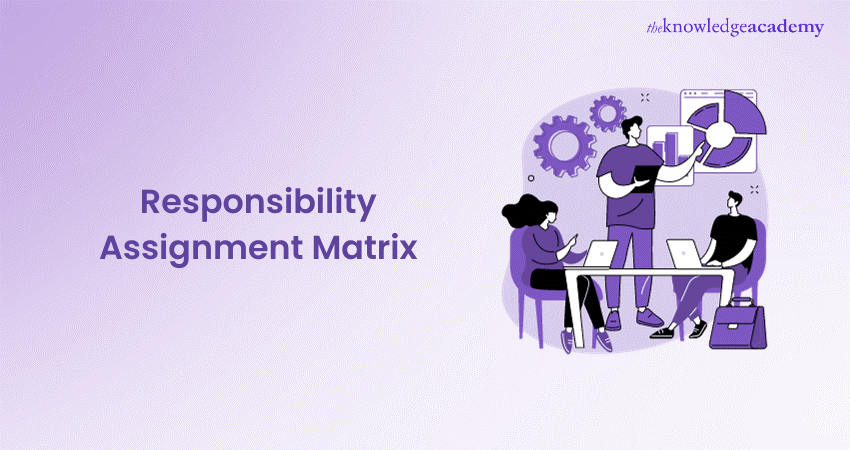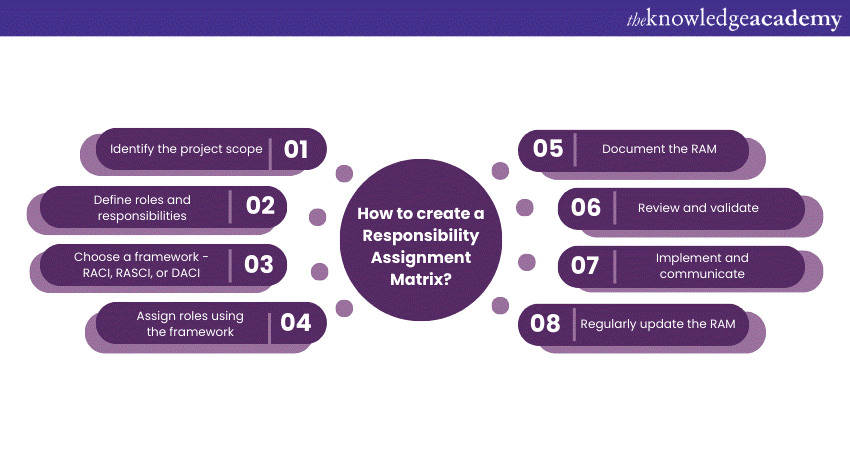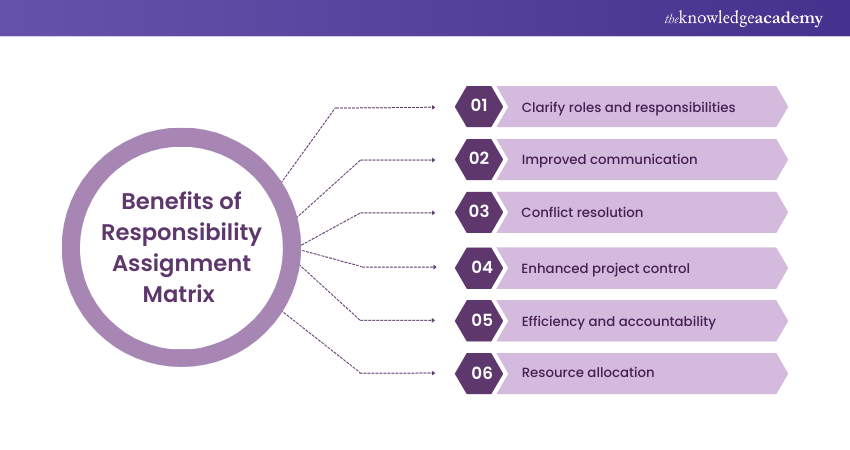We may not have the course you’re looking for. If you enquire or give us a call on 0800 446148 and speak to our training experts, we may still be able to help with your training requirements.
Training Outcomes Within Your Budget!
We ensure quality, budget-alignment, and timely delivery by our expert instructors.

In the dynamic world of project management, where responsibilities and accountabilities often intersect and diverge, a tool that brings order to chaos is invaluable. The Responsibility Assignment Matrix, or RAM, is precisely that tool. A Project Management tool termed as RACI matrix is used to define team members' roles and responsibilities.
This comprehensive blog aims to provide you with a complete overview of the Responsibility Assignment Matrix and its pivotal role in Project Management and organisational structure.
Table of Content
1) What is a Responsibility Assignment Matrix in Project Management?
2) Responsibility Assignment Matrix (RAM) goal in Project Management
3) How to create a Responsibility Assignment Matrix?
4) Benefits of Responsibility Assignment Matrix
5) Developing Responsibility Assignment Matrix (RAM) best practices
6) Conclusion
What is a Responsibility Assignment Matrix in Project Management?
A Responsibility Assignment Matrix (RAM) in Project Management is a tool that outlines and defines the roles and responsibilities of individuals or groups involved in a project. Its purpose is to ensure that everyone understands their specific duties and tasks. The primary purpose of a RAM is to bring clarity to the project structure, helping to prevent confusion, overlap, and accountability issues throughout the project lifecycle.
RAM in Project Management is also known as Responsible, Accountable, Consulted and Informed (RACI). RACI represents different levels of roles and responsibilities for individuals or teams:
a) Responsible: The individual or group in responsible for finishing a certain job or project. They are the ones who perform the work.
b) Accountable: The individuals who have complete responsibility and decision-making authority over the job or result. They ensure that the task is completed and of satisfactory quality.
c) Consulted: Individuals or stakeholders are consulted for their views or skills before to making a decision or taking actions. They contribute essential insights but may not be directly responsible for the task.
d) Informed: Individuals or stakeholders who need regular updates on the task’s progress or result. They are not actively involved in its conclusion, but they must be notified of any advancements.
Responsibility Assignment Matrix goal in Project Management
The primary goal of a Responsibility Assignment Matrix in Project Management is to clearly define and communicate the Roles and Responsibilities of Project Managers and individuals or teams involved in a project. Here are the key goals of using a RAM in Project Management:
a) Clear roles and responsibilities: The RAM establishes clear roles and responsibilities for each team member, minimising confusion and conflicts.
b) Enhanced communication: Documenting roles and responsibilities concisely in the RAM facilitates effective communication within the project team. Also, enabling quick identification of contacts for specific issues or inquires.
c) Conflict resolution: BY operating a reference point, the RAM helps to resolve conflicts or misunderstandings about responsibilities, providing a foundation for conversation and conflict resolution.
d) Improved project control: With the RAM in place, Project Managers and stakeholders can more easily monitor project progress, identifying task accountability and monitoring work package status.
e) Efficiency and accountability: By allocating responsibility to each project aspect, the RAM promotes accountability among team members, resulting in increased efficiency as everyone understands their duties and expectations.
f) Risk Management: The clear roles of RAM help detect potential hazards associated with functional gaps or overlaps in the Risk Management Process, enabling proactive risk mitigation strategies.
g) Optimal Resource Allocation: Project managers can optimise resource allocation by understanding task ownership and workload distribution as described in the RAM.
Ready to lead digital service projects to success? Register for our CDSPM (Certified Digital Services Project Manager) Course today!
How to create a Responsibility Assignment Matrix?
Creating a Responsibility Assignment Matrix involves a structured process to define and allocate roles and responsibilities for a project or a specific task. Here are the steps to create a RAM:

Identify the project scope
Start by recognising the project's scope or the exact purpose for which you are building RAM. This includes establishing project objectives, outcomes, and critical milestones.
Define roles and responsibilities
a) Identify the key roles involved in the project. Common roles may include Project Manager, Team Leader, Team Member, Stakeholders, and other relevant positions.
b) Clearly define the responsibilities associated with each role. These responsibilities should be specific and measurable so there is no ambiguity.
Choose a framework - RACI, RASCI, or DACI
a) Select a framework for your RAM. The most commonly used frameworks are RACI, RASCI, and DACI:
b) RACI: RACI Stands for Responsible, Accountable, Consulted, and Informed. It outlines who is in charge of a task, who is answerable for following it through to completion, who should be consulted, and who should be informed.
c) RASCI: RASCI Similar to RACI, but with an additional role, the "S" for Support. This framework further clarifies who provides support for a task.
d) DACI: This framework is similar to RASCI but adds the role of Driver. The Driver is responsible for ensuring that a task is completed.
Assign roles using the framework
a) For each task or work package within the project, assign the relevant roles using the chosen framework. Each task should have a Responsible person, an Accountable person, and, if necessary, people who need to be Consulted, Informed, or Supported.
b) Be specific and ensure that there is only one person designated as "Accountable" for each task to avoid confusion.
Document the RAM
a) Create a table or chart that lists all the tasks or work packages on one axis and the identified roles on the other.
b) Fill in the matrix with the appropriate role designations (R, A, C, I, S, D) for each task and role.
Review and validate
Share the RAM with the project team and stakeholders for evaluation and approval. Confirm that everyone agrees on the roles and responsibilities.
Implement and communicate
Once the RAM has been completed and approved, communicate it to the project team and other stakeholders. Ensure that everyone understands their jobs and responsibilities.
Regularly update the RAM
As the project evolves, it is critical to improve the RAM as necessary. Roles and duties might shift, and new tasks may develop. Keep the RAM current to reflect the project's evolving needs.
Unlock your potential with our Project Management Courses now!
Benefits of Responsibility Assignment Matrix
A Responsibility Assignment Matrix (RAM) offers several significant advantages when considering Project Management and organisational structure. Here are some of the key benefits of using RAM:

a) Clarify roles and responsibilities: A RAM clearly defines who is responsible for each task, which helps prevent confusion and ensures that team members understand their roles.
b) Improved communication: The RAM serves as a central reference point for roles and responsibilities, promoting effective communication within the project team. Team members can quickly identify who to contact for specific issues or questions.
c) Conflict resolution: When there is a dispute or ambiguity regarding responsibilities, the RAM provides a basis for discussion and conflict resolution. It helps identify where accountability lies and facilitates problem-solving.
d) Enhanced project control: The RAM allows Project Managers and stakeholders to monitor and manage the project's development. It helps you to track the status of assignments and ensure that tasks are getting done as planned.
e) Efficiency and accountability: Clearly defined roles and responsibilities create a sense of responsibility among team members, maybe resulting in improved productivity. When people understand what is required of them, and they are more likely to fulfil it.
f) Resource allocation: The RAM helps Project Managers optimise resource allocation by understanding who is responsible for specific tasks. This ensures that workloads are distributed evenly and that resources are used efficiently.
Developing Responsibility Assignment Matrix best practices
Developing a Responsibility Assignment Matrix is a critical aspect of project management. To create an effective RAM, consider the following best practices:
a) Involve key stakeholders: Define roles and responsibilities after consulting with project stakeholders in regards with Stakeholder Analysis, team members, and subject matter experts. Their participation can provide useful information about the project's objectives.
b) Keep it simple: Use a simple framework (e.g., RACI, RASCI, or DACI) that team members are able to quickly understand and use.
c) Use clear and specific language: In order to prevent confusion, write tasks clearly and precisely. Avoid using confusing or unclear terms that may lead to confusion.
d) Designate a single "accountable" person: Assign only one person as "Accountable" for each task. This individual is ultimately responsible for the task's completion. Multiple accountable persons can lead to confusion and accountability issues.
e) Consult and inform appropriately: It is important to carefully consider the individuals who need to be consulted and informed for each task. Avoid unnecessary involvement, which can lead to inefficiency. Ensure that the right people are included in these roles.
f) Review and validate with the team: Share the RAM with the project team and stakeholders for feedback and validation. Ensure that all parties agree with the assigned roles and responsibilities.
g) Document assumptions and clarifications: If certain roles and responsibilities are based on assumptions or require clarification, document these notes alongside the RAM. This can help avoid misunderstandings in the future.
Join our Project Management Certification today and take the leap towards becoming a project management expert!
Conclusion
A Responsibility Assignment Matrix is an important tool in Project Management and organisational systems. Its importance comes from its capacity to define, assign, and explain the roles and responsibilities, resulting in improved project effectiveness and performance.
Take the next step in your project management career with our Certified Global Project Manager (CGPM) Course!
Frequently Asked Questions

Creating a Responsibility Matrix is appropriate for the project's initiation stage. It outlines roles, duties, and communication channels to promote responsibility throughout the project's lifecycle.

The Responsibility Assignment Matrix or RACI model divides tasks as Responsible, Accountable, Consulted, or Informed. It promotes transparency and accountability among the project group.

The Knowledge Academy takes global learning to new heights, offering over 30,000 online courses across 490+ locations in 220 countries. This expansive reach ensures accessibility and convenience for learners worldwide.
Alongside our diverse Online Course Catalogue, encompassing 17 major categories, we go the extra mile by providing a plethora of free educational Online Resources like News updates, Blogs, videos, webinars, and interview questions. Tailoring learning experiences further, professionals can maximise value with customisable Course Bundles of TKA.

The Knowledge Academy’s Knowledge Pass, a prepaid voucher, adds another layer of flexibility, allowing course bookings over a 12-month period. Join us on a journey where education knows no bounds.

The Knowledge Academy offers various Project Management Courses, including Introduction to Project Management Certification Course, Certified Digital Services Project Manager and Project Management Course. These courses cater to different skill levels, providing comprehensive insights into Types of Project Managers.
Our Project Management Blogs cover a range of topics related to Project Management, offering valuable resources, best practices, and industry insights. Whether you are a beginner or looking to advance your Project Management skills, The Knowledge Academy's diverse courses and informative blogs have you covered.
Upcoming Project Management Resources Batches & Dates
Date
 Introduction to Project Management Course
Introduction to Project Management Course
Fri 17th Jan 2025
Fri 7th Mar 2025
Fri 23rd May 2025
Fri 18th Jul 2025
Fri 12th Sep 2025
Fri 14th Nov 2025
Fri 12th Dec 2025







 Top Rated Course
Top Rated Course



 If you wish to make any changes to your course, please
If you wish to make any changes to your course, please


